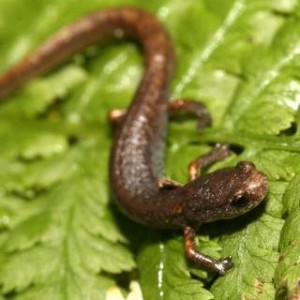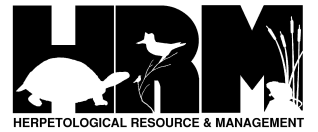Four-toed Salamander
Overview:
Scientific Name: Hemidactylium scutatum
Size: 2 – 4” (adult length)
Status: Generally uncommon, with populations localized.
MDNR Wildlife Action Plan Status: Species of Greatest Conservation Need

Habitat:
Occupy moist deciduous, coniferous, or mixed woodlands, often near spring-feed creeks, bogs, or boggy ponds.
Adult Coloration:
Reddish or grayish brown with black and light bluish speckling down the grayish sides. Belly is a contrasting bright white, sometimes tinted with blue, and with small black spots.
Adult Characteristics:
Very small slender salamander with four toes on each hind foot. 13-14 costal grooves (grooves between rib-like ridges running down sides of body). Males are smaller than females and have relatively longer tails. Male’s snout appears squared off from above while female’s is more rounded.
Larvae Characteristics:
Newly hatched aquatic larvae are yellow, orange, and green tinted on the head, with many black spots that merge into a Y-shaped mark on the back of the head and a dark band behind the eye. Upper tail fin extends up the back and nearly onto the head.
Species Confused With:
No other salamander has a pure white belly with black spots and four-toed hind feet.
References:
- Amphibians and Reptiles of the Great Lakes Region by Jim Harding
- Harding, J.H. and J.A. Holman. 1992. Michigan Frogs, Toads, and Salamanders. MSU Cooperative Extension Service and MSU Museum. Extension Bull. E-2350, 144 pp.
- Ruthven, A. G., H. B. T. Gaige, et al. 1912. The herpetology of Michigan, by Alexander B. Ruthven. Crystal Thompson and Helen Thompson; Memoranda towards a bibliography of the archaeology of Michigan, by Harlan I. Smith; prepared under the direction of Alexander G. Ruthven. Lansing, Mich., Wynkoop Hallenbeck Crawford, State Printers.
- Holman, J. A. 2012. The Amphibians and Reptiles of Michigan: A Quaternary and Recent Faunal Adventure. Detroit, Mich., Wayne State University Press.
- Conant, R., and Collins, J. T. 1998. Reptiles and Amphibians: Eastern, Central North America. Houghton Mifflin Harcourt Press.
